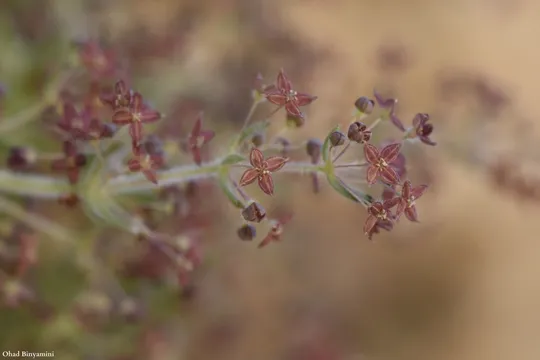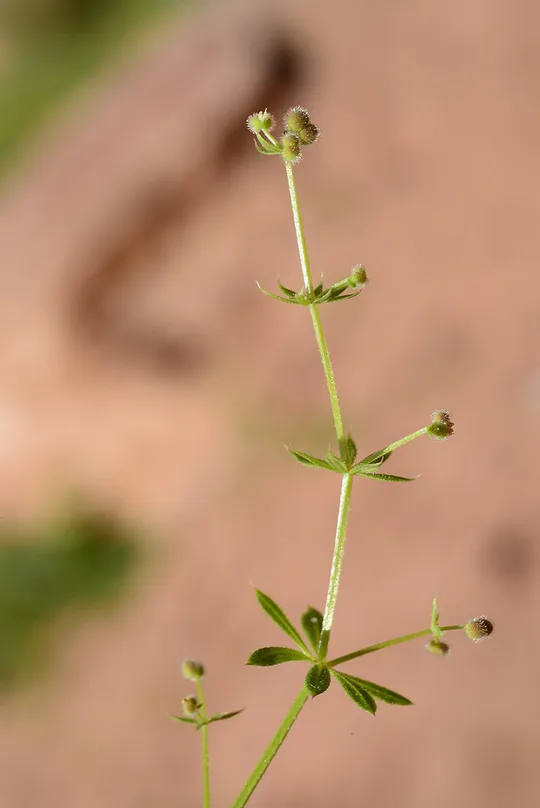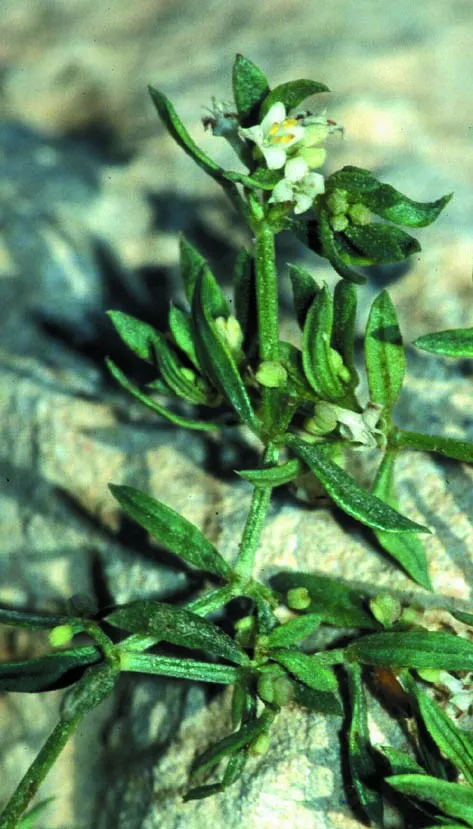Oldenlandia capensis
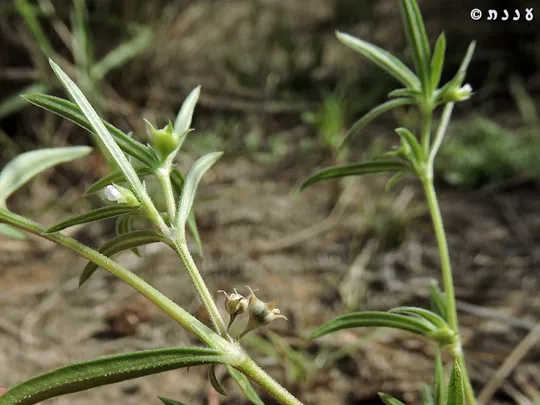
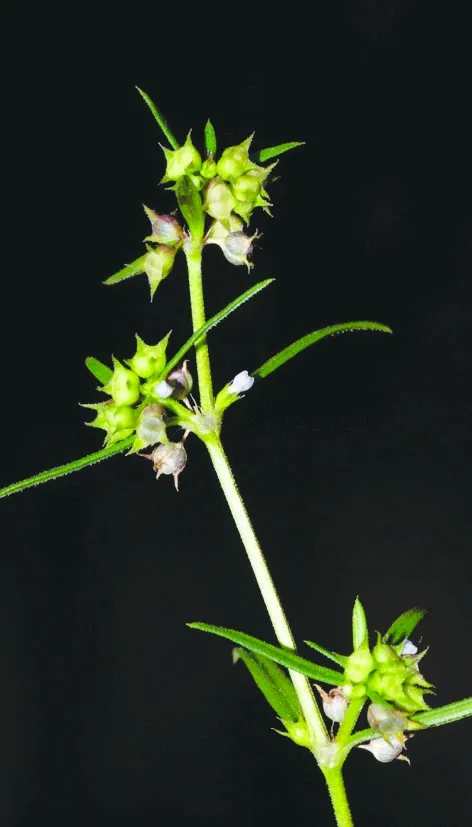
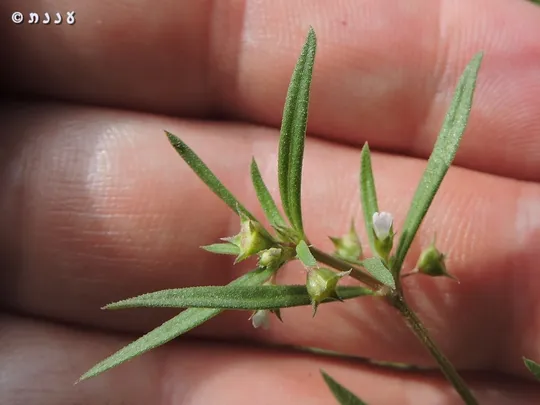
Oldenlandia capensis is small annual plant (5-10 cm) with elongated opposite leaves. The stipules are invisible, united into the leaf petiole. Leaves are much longer than the flowers, which are not prominent. Tiny flowers (3 mm) arranged in groups of 1-4 in the leaf axil. Tubular corolla has a nail-shaped whitish-purple flange. The number of corolla lobes and stamens varies from 4 to 5. O. capensis flowers in August-September. Fruit is a multi-seed capsule integrated in the calyx, with two cells. Two rigid calyx teeth protrude from the top. The species is probably dispersed by birds, as it has a disjunct distribution pattern in wetlands that are far apart.
Formerly found in seven different locations along the coastal plain: three in the Sharon (Wadi Hadera,Brekhat Ya'ar and Dora Pond) three in Philistean Plain (Petah Tikva, Wadi Rubin and Ashdod) and a single site in the Acre Valley. Of these seven sites, six are extinct, and the only surviving site is the Dora Pond where it was recently (2006) found. In addition, two new sites were discovered – a depression in the Yavne Sands and on the banks of the Menashe Reservoirs. Shir Vered discovered the Menashe Reservoirs site in 1990 and since then the population there is stable. The third site is a winter pool in Herzliya found in 2006.
Grows in moist sandy soil depressions between sand dunes and on the margins of ponds and wetlands on the coastal plain. The Menashe Reservoirs collect seasonal floodwater, and Oldenlandia capensis grows there in open areas between Tamarisk trees on seasonally moist sand. The species also grows well in weak light in the shade of tall trees.
The species is similar in its general appearance to small plants from the Caryophyllaceae family, despite belonging to the Rubiaceae, which is systematically distant from the Caryophyllaceae. It can easily be distinguished from the Caryophyllaceae by the shape of the fruit – a thick capsule enveloped by the calyx, which has 4 to 5 lobes.
The genus has 300 species distributed in warm areas of the New and Old World. The center of its range is in Africa and it includes mainly shrubs and herbaceous perennials. The locals produce dyes from the roots of several of the species.
• Habitat loss and destruction are the primary risk factors threatening Oldenlandia capensis. The species grows in a unique and sensitive humid sand habitat, and maintaining the groundwater level close to the surface during its growth and flowering season is essential to its existence. Declining groundwater will prevent its development.
• The plant has a fragmented distribution pattern that follows its fragmented habitat. Its dispersal capability is good and it is probably dispersed by birds. This is suggested by its appearance at the Menashe Reservoirs.
• Between 1996 and 1998, 107 individuals were counted at the Menashe Reservoirs, 50 individuals at the Yavne sands and 1,000 at the Dora Pond. The rapid construction around the Dora Pond in southern Netanya, poses a severe threat to this population, the largest in the country.
• The Dora Pond is an “urban reserve” but is not an officially declared a nature reserve. The other two surviving populations are located outside declared nature reserves.
The humid sand habitat should be protected from domination by herbaceous plants and shrubs such as Calicotome villosa or Imperata cylindrica. The two surviving sites require careful monitoring and the soil crust, where the seed bank of the species is located, should be protected. The Dora Pond should be preserved as the major site for the species. If the area bordering on the Dora Pond will be irreversibly damaged, an alternative site at the Yavne Sands should be selected.
A species whose main distribution is African, penetrating into the southern Mediterranean: it grows in South Africa (from where it was first described hence the name capensis, for the Cape of Good Hope), in East Africa, Arabia, Egypt, Morocco and Algeria. It is mentioned in Lebanese literature, but is probably extinct there.
A minuscule peripheral tropical African species that currently grows in three locations on the coastal plain, in a unique habitat on moist sand bordering on winter pools. Previously known from seven sites. In Israel it is seriously endangered because of the uniqueness of its habitat and the continuing destruction of coastal plain winter pools.
Current Occupancy Map
| 1000 squre meter pixel | 5000 squre meter pixel | 10000 squre meter pixel | |
|---|---|---|---|
| number of observations | 0 | 0 | 0 |
| in total pixels | 0 | 0 | 0 |
| Family | Rubiaceae |
| Classification | On the endangered species list |
| Ecosystem | Coastal area |
| Chorotype | Palaeotropic (Mediterranean) |
| Conservation Site | Dora Pond |
| Rarity |
1
3
6
|
|---|---|
| Vulnerability |
0
4
4
|
| Attractiveness |
0
0
4
|
| Endemism |
0
0
4
|
| Red number |
1
4.2
10
|
| Peripherality | S |
| IUCN category | DD EW EX LC CR EN VU NT |
| Threat Definition according to the red book | Endangered |
 Based on:
Based on:
